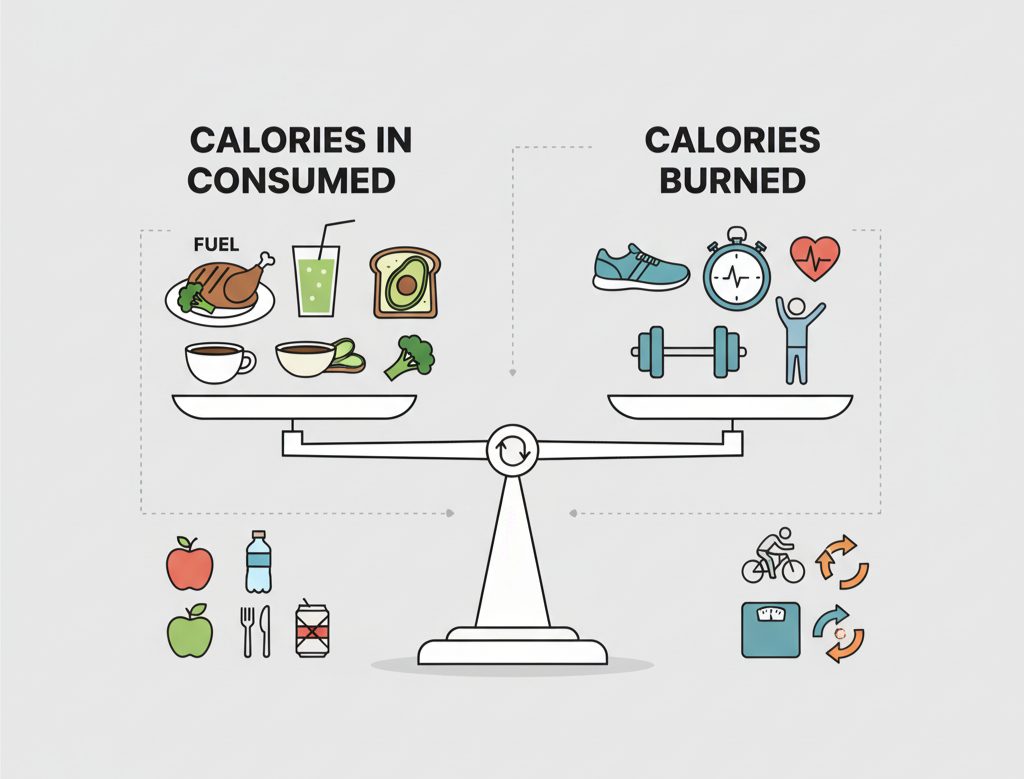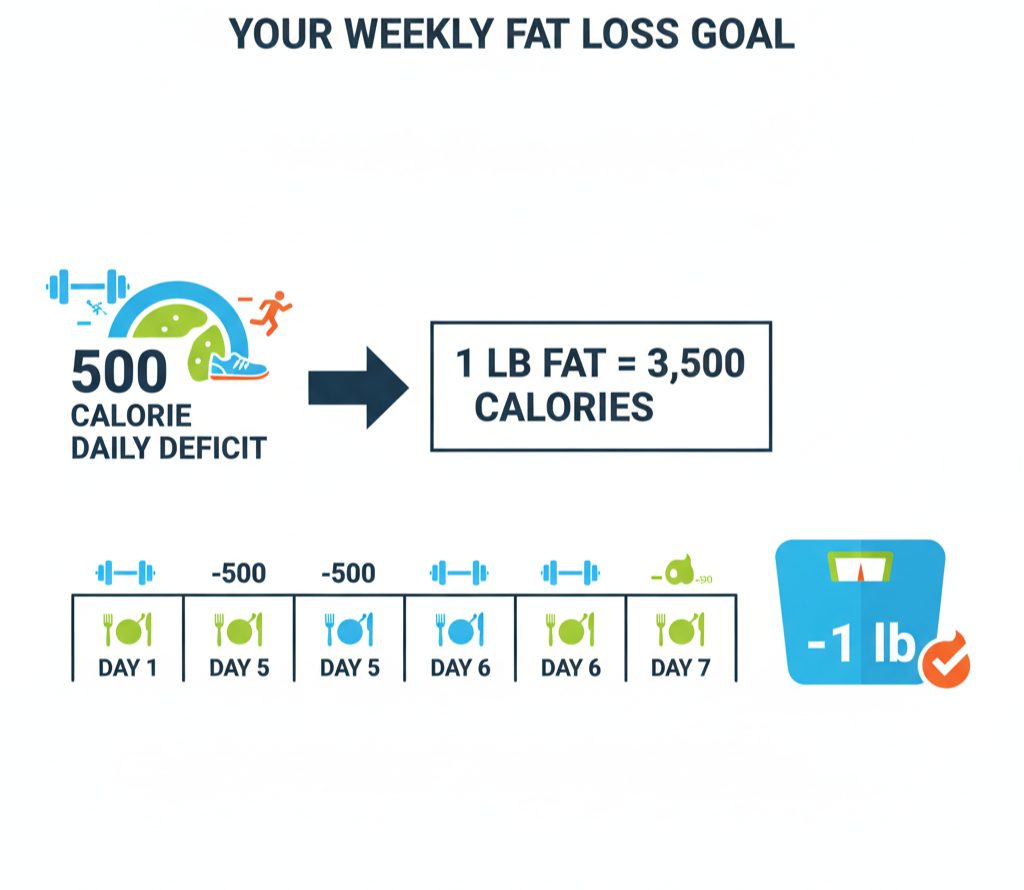What Is a Calorie Deficit?
A calorie deficit occurs when you consume fewer calories than your body uses in a day. Imagine your body as a savings account, where calories are like money you withdraw more than you deposit, and your balance (fat stores) goes down. Think of your body like a bank account. Calories coming in are deposits, and calories burned are withdrawals. When withdrawals exceed deposits, you lose weight. The math is simple: if your body needs 2,500 calories daily to maintain your current weight and you eat only 2,000 calories, you’ve created a 500-calorie deficit. Over time, this deficit forces your body to tap into stored fat for energy, resulting in weight loss. Creating a calorie deficit isn’t about starving yourself. It’s about eating smart and understanding your body’s actual energy needs.Why Calorie Deficit Actually Works
Your body burns calories 24/7, even while sleeping. These burned calories fuel everything from breathing to thinking to walking. When you reduce calorie intake below what your body needs, it must find energy somewhere else. That somewhere else is your stored body fat. Roughly one pound of stored body fat equals about 3,500 calories. So creating a daily deficit of 500 calories leads to losing about one pound per week. This approach is backed by nutrition experts and considered the gold standard for sustainable weight loss. Unlike crash diets that slow your metabolism, a moderate calorie deficit keeps your body functioning normally while steadily burning fat. I learned this the hard way years ago when extreme dieting backfired and I gained everything back. The sustainable approach works.
Step 1: Calculate Your BMR (Basal Metabolic Rate)
Before figuring out your calorie deficit, you need to know your BMR. This is the number of calories your body burns at complete rest just to keep you alive. Use the BMR Calculator on NutriFitCalc.com for instant results, or calculate manually with the Mifflin-St Jeor equation, the most accurate formula available: For men: BMR = (10 × weight in kg) + (6.25 × height in cm) – (5 × age in years) + 5 For women: BMR = (10 × weight in kg) + (6.25 × height in cm) – (5 × age in years) – 161 Let’s say you’re a 35-year-old woman, weighing 70 kg and standing 165 cm tall. Your BMR would be: (10 × 70) + (6.25 × 165) – (5 × 35) – 161 = 1,447 calories. This is just your baseline. You burn more calories through daily activities.Step 2: Determine Your TDEE (Total Daily Energy Expenditure)
Your TDEE represents total calories burned daily, including all physical activity. To find this, multiply your BMR by an activity factor. Try the TDEE Calculator on NutriFitCalc.com to get accurate results instantly:- Sedentary (little to no exercise): BMR × 1.2
- Lightly active (exercise 1–3 days/week): BMR × 1.375
- Moderately active (exercise 3–5 days/week): BMR × 1.55
- Very active (exercise 6–7 days/week): BMR × 1.725
- Super active (intense daily exercise or physical job): BMR × 1.9
Step 3: Create Your Calorie Deficit
Now comes the important part. Subtract calories from your TDEE to create your deficit. Health professionals recommend a deficit of 500–750 calories per day for safe, sustainable weight loss. This creates weight loss of 1–2 pounds weekly, which studies show is more likely to stay off long-term. Using our example, that woman with a TDEE of 2,243 calories should aim for 1,493–1,743 daily calories to lose weight effectively. Calculate your personalized target using the Calorie Deficit Calculator on NutriFitCalc.com. Never go below 1,200 calories daily for women or 1,500 for men without medical supervision. Eating too little can slow metabolism, cause nutrient deficiencies, and make weight loss harder.How to Calculate Calorie Deficit: The Complete Formula
Here’s the full process in one place:- Calculate BMR using the Mifflin-St Jeor equation
- Multiply BMR by activity level to get TDEE
- Subtract 500–750 from TDEE for your daily calorie target
Setting Realistic Weight Loss Goals
A 500-calorie daily deficit leads to losing approximately one pound per week. Want to lose two pounds weekly? You’d need a 1,000-calorie deficit, but this is the maximum recommended without medical supervision. Most people find 500–750 calories easier to maintain long-term than aggressive deficits. Slow and steady really does win the weight loss race. People who lose weight gradually keep it off better than those who crash diet. Set a target timeline. Losing 20 pounds at one pound per week takes about 20 weeks. That might seem long, but compare that to yo-yo dieting for years without lasting results. Check out the Weight Loss Goal Calculator on NutriFitCalc.com to project your exact timeline based on your chosen deficit.
Creating Your Calorie Deficit Diet Plan
You have two main paths to create a calorie deficit: eat less, move more, or combine both. The combination approach works best for most people. Through diet alone: If your TDEE is 2,200 calories, eating 1,700 creates your 500-calorie deficit. Focus on high-protein foods, vegetables, and whole grains that keep you full longer. Use the Macro Calculator on NutriFitCalc.com to balance your protein, carbs, and fats perfectly. Through exercise alone: Burn an extra 500 calories daily through activity. This might include 60 minutes of moderate cardio or a combination of strength and cardio training. The hybrid approach: Cut 250 calories from your diet and burn 250 through exercise. This method is often easiest to stick with because neither change feels extreme. A calorie deficit meal plan should include lean proteins, complex carbohydrates, healthy fats, and plenty of vegetables to ensure you’re getting proper nutrition while losing weight.Common Mistakes When Calculating Calorie Deficit
Many people overestimate how active they are. If weight loss stalls, try adjusting your activity multiplier down one level. Being honest about activity levels gives more accurate results. Another mistake is not tracking food accurately. That “small handful” of nuts can be 200 calories. Use a food scale and tracking app for at least two weeks to learn proper portions. Also, avoid going too low with calories. Your body adapts to severe restriction by slowing metabolism, making future weight loss harder. Stick to the recommended 500–750 calorie deficit for best results. Don’t forget to recalculate every 10–15 pounds lost. As your weight drops, so does your TDEE, meaning you’ll need to adjust your calorie target to continue losing.Using a Weight Loss Calculator
Doing all this math by hand gets tedious. That’s where a calorie deficit calculator becomes invaluable. Quality calculators like those on NutriFitCalc.com take your age, gender, height, weight, and activity level, then instantly provide your BMR, TDEE, and recommended calorie targets for weight loss. Many also project how long it’ll take to reach your goal weight at your chosen deficit. Using a weight loss calculator removes guesswork and helps you stay consistent, which is the real key to long-term success. The Body Fat Calculator and BMI Calculator tools help you track more than just weight, giving you a complete picture of your progress.Tracking Your Progress
Weigh yourself once weekly, same day and time, preferably first thing in the morning. Daily fluctuations from water retention and food volume can be misleading. Take body measurements monthly. Sometimes you lose inches before pounds, especially if you’re exercising and building muscle. Track how you feel. Better energy, improved sleep, and clothes fitting looser are all signs your calorie deficit diet is working, even if the scale moves slowly. If you’re not losing weight after three weeks, reassess your calculations. You might need to adjust your activity level estimate or tighten up food tracking.Adjusting Your Approach
Weight loss isn’t perfectly linear. Some weeks you’ll lose more, others less. That’s completely normal. If you hit a plateau lasting more than three weeks, try one of these adjustments:- Recalculate your TDEE with your new current weight
- Increase exercise intensity or duration slightly
- Double-check portion sizes and tracking accuracy
- Consider a diet break for one week at maintenance calories, then resume your deficit
Maintaining Your Results
Once you reach your goal weight, don’t jump back to old eating habits. Gradually increase calories to your new maintenance level (your TDEE at your new weight). Add about 100–200 calories weekly until weight stabilizes. This prevents rapid regain while letting your body adjust. Continue using your weight loss calculator periodically to ensure you’re staying on track. Many people find maintaining weight easier than losing it once they understand their numbers.Real Success With the Right Numbers
Sarah, a 42-year-old teacher, struggled with weight for years trying random diets. Once she learned to calculate her calorie deficit properly using NutriFitCalc.com’s tools, she lost 35 pounds over seven months and has maintained it for two years now. She didn’t follow any special diet plan. She just ate foods she enjoyed while staying within her calculated target. That’s the power of understanding your numbers.Frequently Asked Questions
Q: How do I calculate my calorie deficit to lose weight? First, calculate your TDEE (BMR multiplied by activity level), then subtract 500–750 calories from that number. This creates a deficit that leads to losing 1–2 pounds weekly, which health professionals consider safe and sustainable. You can use the free calculators on NutriFitCalc.com to get your exact numbers in seconds without manual calculations. Q: What’s the ideal calorie deficit for losing weight safely? A deficit of 500–750 calories per day is considered safe and effective by nutrition experts and healthcare professionals, never dropping below 1,200 calories daily for women or 1,500 for men without medical supervision. Larger deficits may cause muscle loss, nutrient deficiencies, and metabolic slowdown that makes maintaining weight loss extremely difficult long-term. Q: Can I use a calorie deficit calculator instead of manual calculations? Yes, quality calculators provide accurate results instantly and eliminate calculation errors that commonly occur with manual math. The free tools available on NutriFitCalc.com calculate your BMR, TDEE, and personalized calorie targets while projecting your weight loss timeline, making tracking easier and more consistent over time. Q: How long does it take to see results from a calorie deficit? Most people notice changes within 2–3 weeks with a consistent 500-calorie daily deficit, losing approximately one pound per week. However, initial results may vary due to water weight fluctuations, so measuring progress over 4–6 weeks provides a more accurate picture of your fat loss rate and helps determine if adjustments are needed.Disclaimer
The information provided on NutriFitCalc.com is for educational and informational purposes only and should not replace professional medical advice, diagnosis, or treatment. Always consult with a qualified healthcare provider or registered dietitian before starting any weight loss program, especially if you have existing health conditions, are taking medications, or have a history of eating disorders. Individual results may vary based on numerous factors including metabolism, genetics, adherence to the plan, and overall health status. The calculators and tools provided are designed to offer general guidance and should not be considered personalized medical advice. Ready to stop guessing and start seeing real results? Head over to NutriFitCalc.com and use our free calorie deficit calculator to get your personalized numbers in seconds. Calculate your BMR, discover your TDEE, and find out exactly how many calories you should eat to reach your goal weight. No more confusion. Just proven science and a clear path forward. Your transformation starts with one simple calculation today.About the Author
This article is written by the NutriFitCalc Team, a group of Food Science and Nutrition students who create simple, research-backed guides for healthy living. We review global health sources like WHO and CDC to keep our content accurate and helpful.
